Best Microphones for Vlogging and Filmmaking in 2025

If you’re serious about vlogging or filmmaking in 2025, upgrading your audio setup is absolutely crucial. Even the most stunning video footage will fall flat if it’s coupled with tinny, echoing, or muffled sound. The quickest, most dramatic improvement to your productions comes from switching out your camera’s built-in microphone for a dedicated external mic—this is the single most important investment you can make in elevating your content and engaging your audience. In today’s crowded digital landscape, viewers demand crisp, clear audio, and are quick to switch off when presented with poor sound, no matter how compelling your visuals.
In this comprehensive guide, we present the best microphones for vlogging and filmmaking this year. From studio condenser mics for spectacular voice-overs to compact, discreet lavaliers for interviews on the go, and powerful shotgun mics to capture action with laser focus—every recommendation is drawn from hands-on experience by our expert review team. Each mic is analyzed for its features, pros and cons, suitability, and value, ensuring there’s something here for every creator’s needs and budget. Plus, don’t miss our practical ‘How To Choose’ section at the end of this post, where we demystify technical jargon and help you pick the perfect mic for your workflow. Whether you’re ready to level up your YouTube game, start a podcast, or film your next indie masterpiece, read on to find the ultimate audio upgrade.
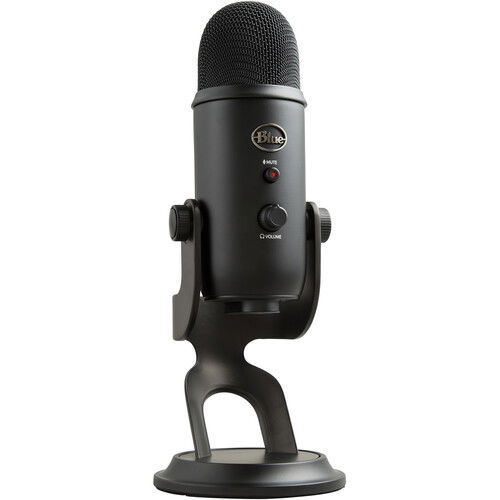
Specifications
- Transducer Type: Condenser
- Form: Studio / Desk
- Polar Patterns: Omnidirectional, Cardioid, Bi-directional, Stereo
- Frequency Response: 15Hz–22KHz
- Power Source: USB
- Windscreen: None included
Pros
- Four selectable polar patterns provide immense versatility
- Outstanding and natural sound quality
- Durable, all-metal construction ensures longevity
- User-friendly controls with simple plug-and-play setup
Cons
- Minimal shock absorption due to thin base padding, may introduce hum
Buy it if
You want a reliable, versatile microphone with exceptional sound quality for voice-overs, streaming, podcasting, or studio-based vlogging.
Don’t buy it if
You need a mic for mobile shooting, or require built-in wind protection for outdoor use.
In Depth Review
The Blue Yeti has become nearly synonymous with content creation—its robust presence in professional studios, gamer setups, and vlogger desks is a testament to its quality. What sets the Yeti apart is its triple capsule array, allowing users to swap among four distinct polar pickup patterns via a simple dial, adjusting on-the-fly to best suit solo voice-overs, face-to-face interviews, group discussions, or ambient sound capture. For vloggers and filmmakers, this means effortless adaptation to evolving shooting situations without having to swap out microphones.
Sound reproduction on the Yeti is rich and clean, faithfully capturing the nuance in vocals and instruments, thanks to its wide frequency response. Whether you’re narrating cinematic travel footage or delivering a dynamic podcast intro, the Yeti offers professional-grade results with minimal setup. Controls are intuitive: a quick-access mute button and dedicated gain adjustment keep essential tweaks at your fingertips, while the zero-latency headphone monitoring ensures you always know how you sound.
Aesthetically, the mic exudes professionalism with its sleek, substantial build quality. It’s sturdy enough to survive years of daily use, though you might want to add external foam or rubber beneath the base to minimize desk-borne vibration.
For stationary vloggers who prize audio clarity and flexibility, the Blue Yeti is hard to beat. Its popularity is well-earned, and its feature set punches well above its price. However, if portability or wind protection is a priority for your workflow, you may want to consider alternative options.
Best For
- Podcasters
- YouTube creators
- Voice-over artists
- Small group recordings in a controlled environment
Blue Yeti USB Microphone at B&H, Adorama.
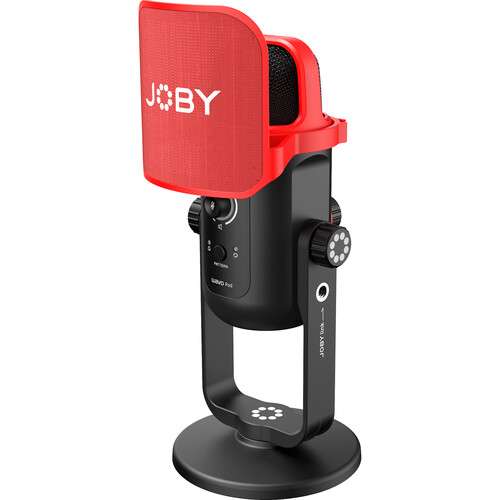
Specifications
- USB Type: USB-C, USB-A
- Mic Type: Condenser
- Polar Pattern: Cardioid, Omnidirectional
- Sample Rate: 48kHz
- Bit Depth: 24-bit
- Extra Connections: 3.5mm headphone jack
Pros
- Affordable alternative to high-end studio mics
- Clean, broadcast-quality audio output
- Adjustable gain for on-the-fly level control
- Vibrant pop shield for visual flair and plosive protection
Cons
- Only two polar patterns—less flexibility than competitors
- Plastic body less robust than metal designs
Buy it if
You seek professional-sounding audio on a budget and don’t require advanced polar pattern options.
Don’t buy it if
You need a highly rugged mic for constant travel or require all-metal construction.
In Depth Review
Landing at the intersection of affordability and professional performance, the Joby Wavo POD brings studio-quality audio within reach for budget-conscious creators. Although it features fewer polar patterns than its pricier rivals, such as the Blue Yeti, its key strength lies in delivering impressive, crisp sound—especially in cardioid mode when recording directly from the front. This makes it ideal for single-host podcasts, streaming, or solo vlogging sessions.
The included vibrant orange pop shield is not just an aesthetic touch designed to catch eyes on camera; it also significantly reduces harsh plosive sounds, resulting in warmer, more intelligible speech. For creators who film themselves, this detail improves both the look and the listen. The multi-function knob streamlines adjustments, letting you tweak monitoring volume or mic input levels without needing to navigate complex software.
While the microphone’s plastic shell keeps weight and manufacturing costs down, it doesn’t sacrifice performance—audio remains consistently spacious and full-bodied. The built-in headphone output supports real-time monitoring, allowing users to easily catch unwanted noise or pops before hitting “record.” Connectivity is user-friendly, with both USB-A and USB-C compatibility ensuring broad device support, including many smartphones and tablets.
The real value proposition of the Wavo POD is that, at a price point well below many rivals, it delivers a level of audio fidelity that can seriously elevate both beginner and intermediate production. The tradeoff for the lower cost comes in the form of limited polar pattern options and a less rugged build, but for home studios, podcasts, or desk-bound vlogging, this is more than adequate.
Best For
- Budding podcasters and streamers
- Students or creators on a tight budget
- Small home studio setups
JOBY Wavo POD Desktop USB Microphone at B&H, Adorama.
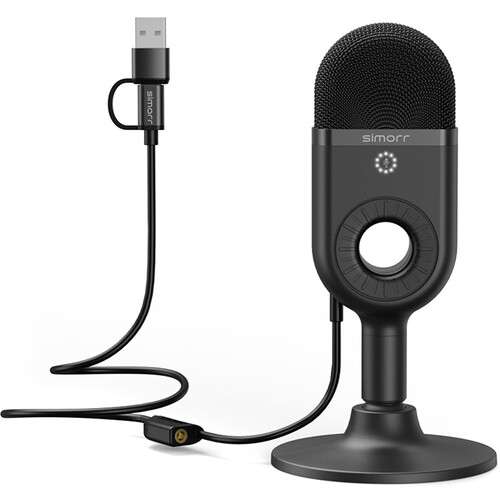
Specifications
- USB Type: USB-C
- Mic Type: Condenser
- Polar Pattern: Cardioid
- Sample Rate: 48kHz
- Bit Depth: 24-bit
- Extra Connections: 3.5mm headphone jack
Pros
- Ultra-compact and highly portable
- Integrated headphone monitor socket for real-time feedback
- Easy, plug-and-play connectivity
- Surprisingly rich and clear audio for its price and size
Cons
- Single, fixed polar pattern limits recording versatility
- Glossy white model reveals scratches and wear
Buy it if
You’re a beginner looking for affordable, substantial improvement over built-in mics and want “set and forget” operation.
Don’t buy it if
You need multiple polar patterns, premium aesthetics, or plan to frequently change recording scenarios.
In Depth Review
The simorr Wave U1 is a compact powerhouse geared toward newcomers in content creation. Standing at about half the height of the Blue Yeti, it’s ideal for those with limited desk space or for creators frequently on the move. Despite its diminutive size, its condenser capsule delivers warm, full-bodied audio, representing a noticeable leap over any standard laptop or computer microphone.
Usability is a highlight. A dedicated, touch-sensitive mute button lets you silence the mic instantly—perfect for live streaming or video calls when unexpected interruptions occur. The onboard gain dial allows real-time adjustment of input levels, granting beginners the chance to experiment without delving into complicated post-processing or software controls. The addition of a 3.5mm headphone jack means you can monitor your recording live, catching issues before they become problems.
Build quality, while not luxurious, is practical for its price. The microphone’s plastic body feels light without being overly fragile, though users should be mindful that the white version may show scuffs over time. The cardioid pickup pattern is focused on sources directly in front of the mic, offering isolation from environmental noise in home settings—ideal for voice recording, podcasting, or solo streaming.
Sound quality, though not at the absolute forefront of the studio market, is reliably clean and much richer than integrated solutions. While advanced users may seek greater versatility or more nuanced acoustic profiles, for its intended audience, the Wave U1 excels.
Best For
- Entry-level vloggers and podcasters
- Remote workers and students
- Travelers who need a high-quality, portable mic
SmallRig simorr Wave U1 USB Condenser Microphone at Adorama, B&H.
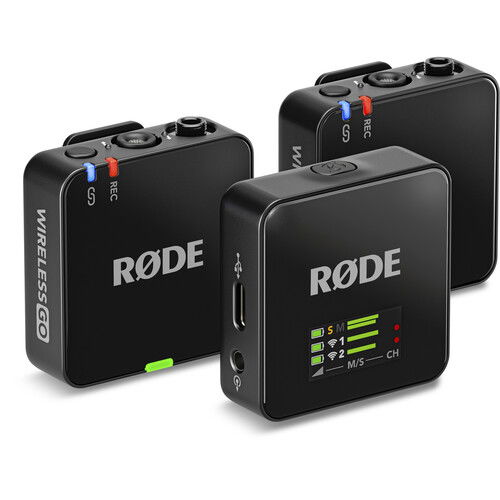
Specifications
- Transducer Type: Pre-polarized pressure transducer
- Form: Clip-on pack
- Polar Pattern: Omnidirectional
- Frequency Response: 20Hz–20KHz
- Power Source: Inbuilt lithium-ion, rechargeable via USB
- Windscreen: Furry included
Pros
- Dual-microphone system for interviews or two-person shoots
- “Intelligent Gain Assist” keeps sound levels optimal automatically
- Exceptionally clear, broadcast-grade audio
Cons
- Transmitters are a bit bulkier than some competitors
Buy it if
You need to capture multiple voices wirelessly, want top reliability, and value quick setup with consistently clean results.
Don’t buy it if
You require ultra-discreet transmitters or are working with extremely tight space for mounting hardware.
In Depth Review
The Rode Wireless Go Gen 3 has set the benchmark for wireless lavalier microphones in the world of content creation. Benefiting from incremental improvements over its highly successful predecessors, this version streamlines audio capture, ensuring even novice users can achieve excellent-sounding recordings straight out of the box.
Its dual-mic system makes it uniquely suited to interviews, co-hosted vlogs, or filmmaking scenarios where multiple subjects need to be mic’d up. The real technological leap, however, is the Intelligent Gain Assist, an automated feature that adjusts input sensitivity in real time. By mimicking the adjustments a professional audio engineer would make, the Wireless Go Gen 3 reduces the risk of distortion and maintains clean, intelligible speech that doesn’t require extensive post-production tinkering.
Range is a non-issue—even through obstructions and at distances up to 50 meters in challenging indoor environments, the connection held firm with minimal lag. Rode claims up to 260 meters in ideal conditions—a range that few creators will ever fully exploit but speaks to the robustness of the wireless link. The near-zero latency codec means that what you hear is in sync with your visuals, avoiding the dreaded post-production audio drift.
Battery life is ample for almost any shoot, and recharging through USB is fast and efficient. The furry windscreen included in the box provides solid protection against wind noise during outdoor shoots, and the clip-on design is straightforward and flexible.
For creators shooting interviews, documentaries, or two-person vlogs, the Rode Wireless Go Gen 3 is arguably the gold standard. It’s portable, dependable, and delivers sound quality that rivals much more expensive professional setups.
Best For
- Interview and dialogue-heavy vlogs
- On-location filmmaking
- Multi-person YouTube content
Rode Wireless GO GEN 3 Compact Microphone System at B&H, Adorama.
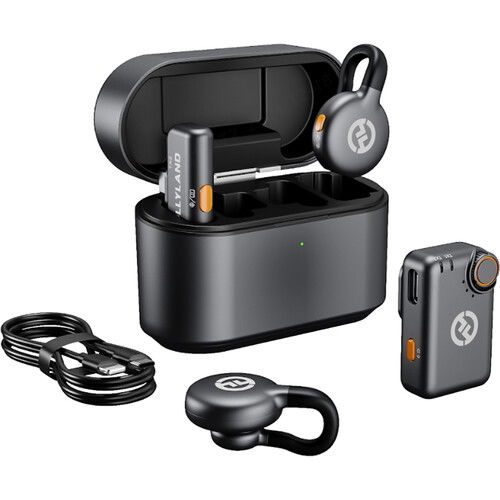
Specifications
- Form: Hook-on pack with pearl-sized transmitter
- Polar Pattern: Omnidirectional
- Frequency Response: 20Hz–20KHz
- Power Source: Inbuilt battery (USB rechargeable with portable case)
- Windscreen: Furry included
Pros
- Incredibly discreet, tiny design
- Excellent audio fidelity and detailed vocals
- Effective built-in noise reduction
Cons
- Occasional signal drop-outs if line of sight is broken between transmitter and receiver
Buy it if
You need a nearly invisible mic for documentary, corporate, or stealthy filming in tight spaces.
Don’t buy it if
You consistently record in environments where moving behind obstacles is common.
In Depth Review
The Hollyland Lark M2S redefines how subtle a wireless lavalier mic can be. With a transmitter about the size of a pearl, this mic can be effortlessly concealed on shirts, jackets, or even under clothing, offering a dramatic improvement over previous, bulkier designs. For creators who prioritize clean visuals, such as documentary filmmakers or corporate video producers, the Lark M2S is almost invisible while still delivering robust, detailed audio.
Transmission reliability is excellent for its size, with a maximum range pushing up to 300 meters. In tests, occasional drop-outs occurred only when the user turned their back and disrupted the direct line of sight—a rare scenario for most stationary interviews or vlogging setups. The omnidirectional capsule captures voices consistently while allowing the subject to move naturally without volume dips or tonal changes.
Audio quality is particularly strong at this price point. With a 24bit/48kHz sampling capability, vocals come through warm, clear, and faithful, handling both booming voices and soft-spoken contributors well. The integrated noise reduction system works impressively, suppressing background hum and hiss without lending the synthetic, bit-crushed quality seen in some other wireless systems. Wind protection is solid thanks to the included furry cover.
The portable charging case not only ensures you’re always powered up but also makes transporting the tiny mics secure and effortless. Build quality is sturdy, especially considering the small form factor.
For filmmakers or vloggers needing a professional, set-it-and-forget-it lavalier that won’t distract from the subject on-screen, the Lark M2S is an exceptional upgrade.
Best For
- Documentarians
- Corporate and stealthy video production
- Those shooting interviews where visibility and distraction matter
Hollyland LARK M2S Combo 2-Person Wireless Microphone System at B&H, Adorama.
6. Best Beginner Lav Mic: DJI Mic Mini
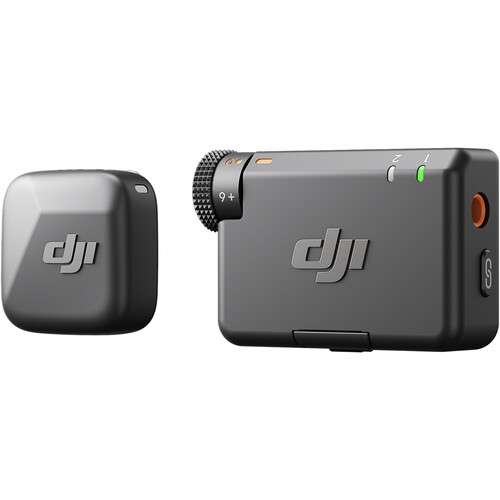
Specifications
- Transducer Type: Pre-polarized pressure transducer
- Form: Clip-on pack with charging case
- Polar Pattern: Omnidirectional
- Frequency Response: 20Hz–20KHz
- Power Source: Integrated battery, USB-charged case
- Windscreen: Furry included
Pros
- Super-lightweight and small
- User-friendly operation perfect for non-technical users
- Long battery life with portable charging case
Cons
- No built-in safety track or monitor display
- Lacks extended features found in pricier wireless systems
Buy it if
You’re new to wireless microphones and want easy, phone-based operation without complicated setup.
Don’t buy it if
You need advanced safety features or plan to edit extensively in post-production.
In Depth Review
For aspiring creators who need a no-fuss, dependable audio solution, the DJI Mic Mini is a stellar entry point into the world of wireless lavalier recording. With its super compact profile and intuitive controls, it’s designed for streamlined operation—simply clip it on, connect to your smartphone, and start recording.
The design prioritizes lightness and portability. Both transmitters and receivers are featherweight, eliminating the bulk that often deters mobile filmmakers or street interviewers. The charging case not only provides safe storage but also keeps the system ready for full-day shoots, recharging units quickly and efficiently.
Audio is delivered in high, clear detail, with 24-bit or 16-bit Bluetooth transfer offering more than enough fidelity for YouTube, TikTok, or Instagram workflows. Connectivity is direct to your phone, catering perfectly to the fast-paced, mobile editing styles predominant on today’s social platforms. There is no safety track (an extra, quieter recording as a backup), but for beginners or more casual users, the clear, interference-free sound on the main track is usually sufficient.
Despite lacking an LCD monitor for levels, the simplicity works in its favor—there is little to set up, and almost nothing to go wrong, minimizing hurdles for novices.
In both testing and real-world usage, the DJI Mic Mini has proven to be a reliable performer, handling obstacles between transmitter and receiver gracefully. While more advanced users might seek out the extra security of a safety track or higher bitrate recordings found in premium wireless mics, for the everyday vlogger or one-person production team, this lightweight solution strikes a great balance between price, convenience, and quality.
Best For
- First-time vloggers and YouTubers
- Social media creators
- On-the-go interviews where minimal setup is essential
DJI Mic Mini Compact Wireless Microphone System at B&H, Adorama.
7. Best Wired Lav Mic: BOYA BY-M1
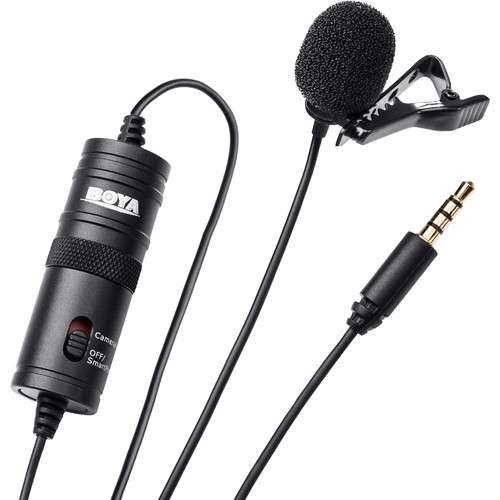
Specifications
- Transducer Type: Condenser
- Form: Lavalier
- Polar Pattern: Omnidirectional
- Frequency Response: 65Hz–18KHz
- Power Source: LR44 battery
- Windscreen: Foam
Pros
- Excellent value with above-average sound quality for price
- Low noise floor for clean recordings
- Impressive 6-meter cable for flexibility
Cons
- Capsule is on the larger side for a lavalier
- Construction requires careful handling to avoid damage
Buy it if
You’re seeking a wired lav mic for interviews, voice-overs, or hands-free vlogging, and need maximum budget efficiency.
Don’t buy it if
You want wireless freedom or ultra-compact build quality.
In Depth Review
When maximum reliability and affordability are top priorities, the Boya BY-M1 proves why it remains one of the most popular wired lavalier microphones for budding creators. The omnidirectional condenser design makes it highly effective at capturing a full, natural vocal tone regardless of the subject’s movement—perfect for interviews, monologues, and product demos.
The included 6-meter cable affords ample flexibility for camera positioning, allowing for clean, clutter-free wide shots without sacrificing sound quality. Clip-on attachment is straightforward, while the bundled foam windscreen reduces wind noise and plosives during outdoor or lively indoor shoots.
Sound output is surprisingly professional for its price point. The mic produces a strong, clear signal, with well-managed sensitivity to avoid picking up excessive background noise. The noise floor—how much hiss or static is present with no speaking—is impressively low, especially when compared to most built-in camera mics. In controlled testing with a Canon EOS 5D Mark III, the recordings were virtually hiss-free, and speech remained crisp and intelligible.
While the capsule is somewhat larger than premium lavaliers, making it slightly more visible on camera, this is a minor compromise given the cost savings. Build quality is adequate for careful use, though not rugged enough for abuse or heavy travel. The powered design means it’s flexible across a variety of devices, but users must remember to switch the power on or off based on what they’re plugging into.
For creators starting out or anyone seeking a backup audio solution, the Boya BY-M1 combines straightforward use with results that punch far above its weight class.
Best For
- Beginners and hobbyists
- Budget YouTube or interview production
- Backup recording for seasoned filmmakers
BOYA BY-M1 Omnidirectional Lavalier Microphone at B&H, Adorama.
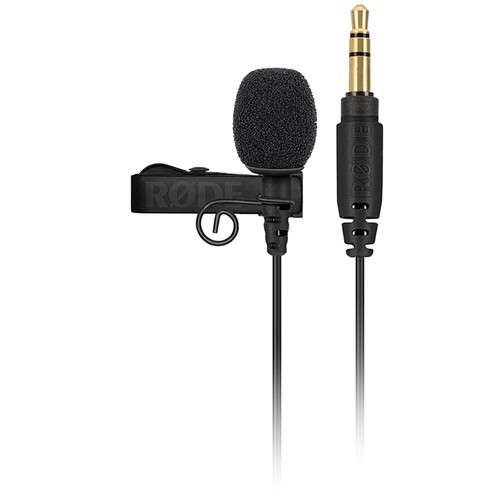
Specifications
- Transducer Type: Condenser
- Form: Lavalier
- Polar Pattern: Omnidirectional
- Frequency Response: 20Hz–20KHz
- Power Source: via device mic socket
- Windscreen: Pop shield
Pros
- Broadcast-grade audio
- Highly compatible with a range of devices (black or white model for discretion)
- Kevlar-reinforced cable for durability
Cons
- Higher price than entry-level models
- Wind muff is not included by default
Buy it if
You need professional-quality lav recordings for television, documentary film, or high-end YouTube content.
Don’t buy it if
Budget is your primary concern, or you frequently shoot outdoors without additional accessories.
In Depth Review
The Rode Lavalier Go is purpose-built for discerning creators who need broadcast-ready performance in a tie-clip microphone. With its omnidirectional condenser capsule, the Lavalier Go captures speech with clarity and warmth, handling both soft nuances and assertive delivery without distortion. This makes it an exceptional choice for interviews, on-location reporting, or scripted dialogue in film production.
Versatility is one of this mic’s key strengths. While designed to integrate seamlessly with the Rode Wireless Go ecosystem, the 3.5mm TRS connector means it can be plugged directly into most cameras, audio recorders, and wireless transmitters, offering maximum flexibility across a range of setups. Its Kevlar-reinforced cable not only resists wear and tear on busy shoots, but also provides a tangle-free experience.
Audio performance is impressive across the full frequency range, with excellent intelligibility and a pleasing tonal balance that flatters most voices. Whether clipped openly or discreetly placed beneath clothing, the Lavalier Go adapts to any scenario. The included foam pop shield provides some protection against breath and wind noise, but for outdoor shoots, the optional RØDE Minifur-Lav windjammer is highly recommended for optimal results.
Though more expensive than most entry-level lavaliers, the professional-grade craftsmanship, sound fidelity, and broad compatibility make it more than worth the investment for creators who won’t compromise on audio quality.
Best For
- Professional on-camera work
- Film and TV production
- Wedding and event videographers
RODE Lavalier GO Omnidirectional Lavalier Microphone at B&H, Adorama.
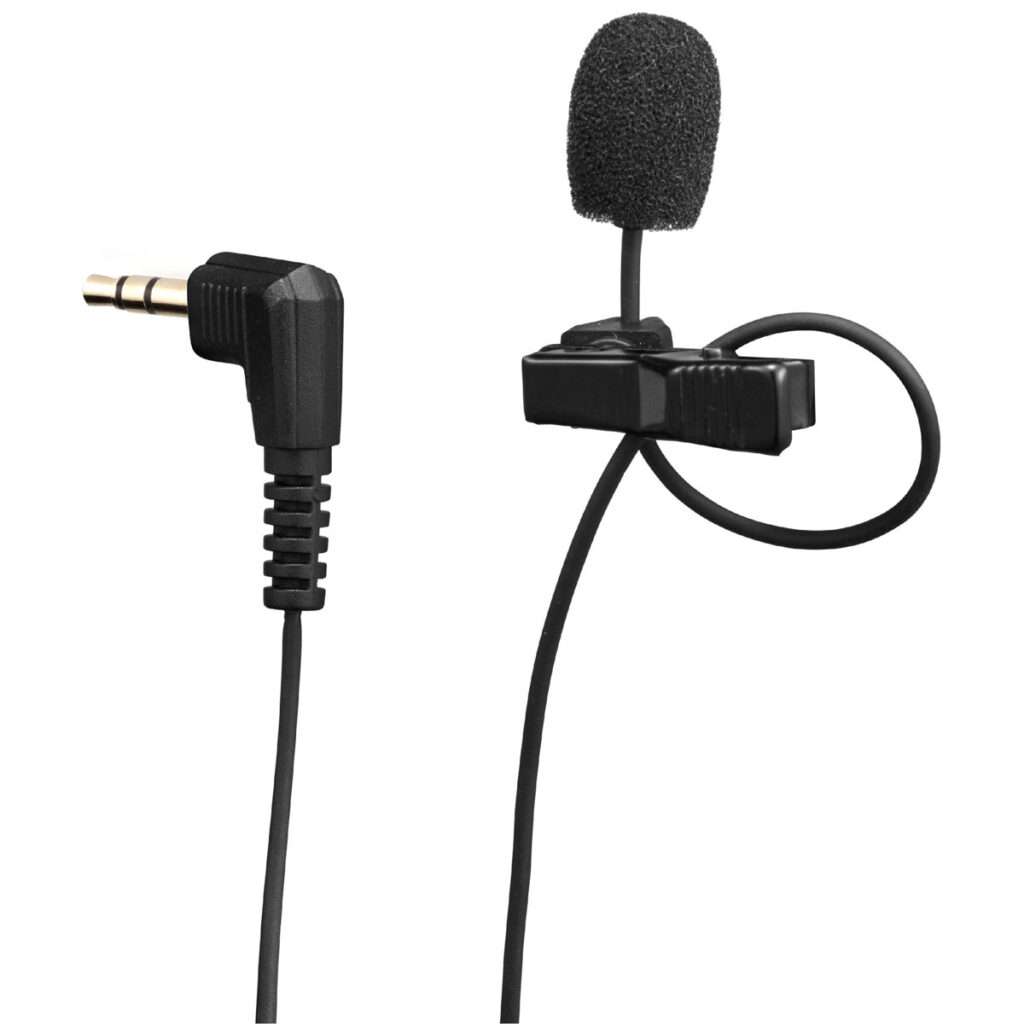
Specifications
- Transducer Type: Condenser
- Form: Lavalier
- Polar Pattern: Omnidirectional
- Frequency Response: 20Hz–20KHz
- Windscreen: Foam
Pros
- Ultra-discreet capsule minimizes distraction on camera
- Warm, high-definition voice reproduction
- Long, high-quality cable adds setup flexibility
Cons
- Long cable can be cumbersome and prone to tangling
- Does not directly connect to smartphones without an adapter
Buy it if
You want unobtrusive, pro-grade lav audio in a studio or camera-based setup.
Don’t buy it if
You need direct smartphone connectivity or have minimal tolerance for cable management.
In Depth Review
The Joby Wavo Lav Pro fills a unique niche with its focus on both sonic excellence and near-invisibility on screen. Tiny yet mighty, its compact capsule is tailored to creators and filmmakers who want their audio gear to be heard but not seen—ideal for interviews, documentaries, or unscripted shoots where gear visibility diminishes professionalism.
Vocals are captured with impressive warmth and clarity, benefiting from the omnidirectional design which reliably records consistent sound even if the speaker turns their head. The extended 2.5-meter (8.2 ft) cable, while potentially tangle-prone, offers ample reach to keep your subject mobile or frame classic “talking head” compositions with flexibility. The overall build exudes quality; both cable and microphone are robust enough for extended use.
Paired with Joby’s ecosystem or standalone recorders, the Wavo Lav Pro elevates any production’s speech intelligibility without adding visual clutter. The included foam windscreen efficiently shields against pops and minor wind noise. However, users wanting to record directly into smartphones will need an adapter, as the default connection does not natively support mobile inputs.
For demanding productions where every on-camera detail matters, the Wavo Lav Pro is a discreet yet potent tool, ensuring that professional-quality audio aligns with visually polished content.
Best For
- Documentary crews
- Interviewers
- Discreet, on-camera presentations
JOBY Wavo Lav PRO Omnidirectional Lavalier Microphone at Adorama.

Specifications
- Transducer Type: Condenser
- Form: Shotgun
- Polar Pattern: Supercardioid
- Frequency Response: 100Hz–16KHz
- Power Source: Plug-in power (no battery required)
- Windscreen: Foam included
Pros
- Affordable, delivering significant audio upgrades over built-in mics
- Compact form, ideal for small cameras and mobile setups
- USB functionality allows for versatile use
Cons
- No battery, so relies on recorders/camera supplying plug-in power
- Doesn’t include USB cables, and requires TRS headphones for monitoring
Buy it if
You want to boost audio quality on a budget and need a simple solution for varied shooting environments.
Don’t buy it if
You require advanced in-mic controls or plan to monitor audio directly with non-standard headphones.
In Depth Review
The Rode VideoMic Go II-H is proof that upgrading to quality shotgun audio doesn’t have to break the bank. It delivers strong, focused sound in a package that’s easy to mount, power, and use—no batteries or complicated settings required. The supercardioid pattern helps concentrate on the subject directly in front of the mic, reducing side and rear noise, which proves invaluable for solo vloggers, run-and-gun shooters, or anyone recording in bustling environments.
The mic’s simple design is complemented by a highly effective shock mount, which minimizes bump and handling noise even when shooting handheld. Plug-in power makes for a cable-only connection—once attached to your camera or compatible recorder, you’re ready to roll with no further adjustments needed. Rich, full sound reproduction extends through the vocal range, and the supplied foam windshield effectively tames indoor wind and plosive noises.
Another standout feature is its USB capability, letting you use the mic for direct-to-computer voice-over or podcast recording—a level of versatility rarely seen at this price. However, the absence of included USB cables means an additional purchase for desktop work, and users should ensure their headphones have the compatible TRS jack for direct monitoring in this mode.
Overall, the VideoMic Go II-H’s robust performance, simplicity, and affordability make it an excellent step up from in-camera mics, providing creators with quality audio for a fraction of the cost of more complex setups.
Best For
- Budget-conscious YouTubers
- Indie filmmakers
- Field interviews and on-location vlogs
RODE VideoMic GO II-H Ultracompact Shotgun Microphone at B&H, Adorama.
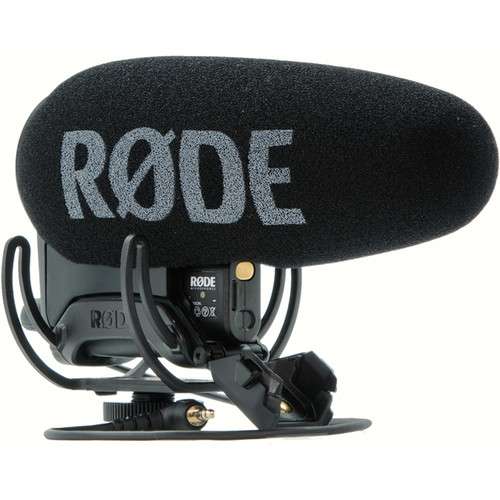
Specifications
- Transducer Type: Condenser
- Form: Shotgun
- Polar Pattern: Supercardioid
- Frequency Response: 40Hz–20KHz
- Power Source: 9V battery
- Windscreen: Foam (Deadcat windjammer available separately)
Pros
- Class-leading sound quality and tonal depth
- On-mic controls for gain and frequency response
- Long battery life, tailored for professional use
Cons
- Requires purchase of additional windjammer for serious outdoor use
- Larger and heavier than entry-level shotgun mics
Buy it if
You’re committed to investing in top-notch location sound and need flexible audio controls.
Don’t buy it if
You’re looking for the lightest possible setup or want integrated wind protection.
In Depth Review
For serious filmmakers and seasoned vloggers, the Rode VideoMic Pro is a workhorse shotgun mic that prioritizes quality and control over compactness. Mounted conveniently via a camera hotshoe, it brings professional-level audio to DSLRs, mirrorless cameras, and field recorders. Its robust shock mounting system minimizes handling noise, while its supercardioid pattern focuses tightly on the subject, ensuring dialogue and voice-overs cut through background sounds with clarity.
What makes the VideoMic Pro stand out are its dual control switches—one for gain (offering -10, , and +20 dB settings) and another for switching between a flat and low-cut frequency response. This allows users to tailor the microphone’s behavior to the shooting environment, preventing clipping when recording loud sources or attenuating low-frequency rumble in noisy locations.
Sound quality is exceptional, particularly for speech, delivering rich, balanced tones with a low self-noise floor—comparable to some of the best lavaliers on the market. The supplied foam windscreen works well indoors, but any outdoor shoot should incorporate the optional “deadcat” for maximum wind protection.
A single 9V battery powers the mic for up to 70 hours, ensuring you won’t run out of juice mid-shoot. However, the added battery compartment and larger chassis mean the VideoMic Pro is slightly bulkier and heavier than entry-level models like the Go II.
While costing more and demanding a bit more space in your kit bag, the VideoMic Pro rewards creators with its superior feature set and unmatched recording quality.
Best For
- Documentary filmmaking
- On-location interviews and dialogue
- Videographers requiring premium, adjustable on-camera audio
RODE VideoMic Pro Camera-Mount Shotgun Microphone at B&H, Adorama.

Specifications
- Transducer Type: Condenser
- Form: Shotgun
- Polar Pattern: Supercardioid
- Frequency Response: 20Hz–20KHz
- Power Source: Plug-in power
- Windscreens: Foam and furry included
Pros
- Ultra-lightweight and compact
- Includes both foam and furry windshields out of the box
- Extremely easy to set up and use
- Offers professional-grade sound for a tiny mic
Cons
- Still larger than some clip-on mics
- Analog-only 3.5mm output, no digital monitoring options
Buy it if
Portability is essential and you want a lightweight, effective shotgun mic for run-and-gun shooting.
Don’t buy it if
You require direct digital output or plan to monitor audio through USB.
In Depth Review
The RODE VideoMicro II takes everything creators love about on-camera shotgun mics and distills it into the most portable, user-friendly package possible. Weighing in at just a few ounces, this microphone is a dream setup for mobile vloggers, travelers, or anyone who needs to keep their camera rig as light and agile as possible.
Despite its small size, the VideoMicro II delivers impressively full-bodied, detailed sound, with a supercardioid pattern that keeps recording focused on the action in front of the lens while minimizing environmental distractions. The included shockmount—the new ‘Helix’ model—is highly effective at eliminating vibrations, so even handheld or action-intensive shooting doesn’t introduce unwanted thumps or rumbles.
Setup could not be more straightforward: no batteries, no menus, and no switches. Just plug into your 3.5mm microphone input and start recording. The inclusion of both foam and furry windshields right in the box is a massive value add, preparing you for indoor studio shoots as well as breezy outdoor environments with minimal additional purchases.
The only trade-off is a lack of direct USB audio output or onboard headphone monitoring, but for on-the-go videographers and new creators, these features are rarely missed. The 3.5mm analog output guarantees universal compatibility with cameras, recorders, and many mobile devices.
For anyone needing quick setup, high portability, and great sound in a tiny form factor, the VideoMicro II is an unbeatable choice.
Best For
- Travel vloggers
- Run-and-gun shooters
- YouTubers needing a compact, backup shotgun mic
RODE VideoMicro II Ultracompact Camera-Mount Shotgun Microphone at B&H, Adorama.
How to Choose the Best Microphone
Identifying Your Needs
The right microphone for you depends not just on your budget, but on your shooting style and environment. Here’s how to break it down:
- Studio Mics: Ideal for voice-overs, podcasts, or stationary vlogging setups. Best in controlled indoor environments with little ambient noise.
- Lavalier Mics (Wired/Wireless): Best for interviews, dialogue scenes, or situations where the mic needs to be close but discreet. Wired models guarantee reliability, while wireless models offer unrivaled freedom of movement.
- Shotgun Mics: The classic choice for on-camera mounting. They excel in isolating sound coming directly from the camera’s perspective, making them perfect for dynamic vlogging, outdoor reporting, and filmmaking.
Understanding Key Terms
- Polar Pattern: Dictates where a mic picks up sound. Cardioid and supercardioid (focused in front), omnidirectional (all directions), bidirectional (front and rear).
- Frequency Response: The wider and flatter, the more natural the captured sound. Good mics cover at least 100Hz–8KHz for human speech, while pro models reach 20Hz–20KHz.
- Plug-in Power vs. Phantom Power: Check your device’s compatibility—studio mics may require USB (direct power) or XLR with phantom power; most cameras supply plug-in power for shotguns and lavaliers.
Top Tips
- Portability vs. Quality: Studio mics deliver the best sound, but may not be practical on the move. Lavalier and compact shotgun mics bridge the gap for mobile creators.
- Flexibility: Wireless systems are great for movement but always keep a wired backup if possible.
- Accessories: Don’t overlook essential extras like windshields, pop filters, and adapter cables—they make a big difference in the field.
FAQs
What’s the difference between cardioid and omnidirectional?
Cardioid mics pick up sounds mainly from the front and sides—great for isolating your voice from background noise. Omnidirectional mics grab sound equally from all directions, ideal when the subject moves or for multi-person setups.
Do I really need an external mic?
Absolutely! Even the best built-in mics can’t match a dedicated external mic’s clarity, depth, and noise rejection.
What’s a shotgun mic?
A long, cylinder-shaped mic designed for highly directional audio—aim at your subject, and it’ll minimize everything else.
What if my mic needs phantom power?
Check your recording equipment. Many professional cameras and recorders can supply 48V “phantom power” through XLR; if you’re using USB or 3.5mm devices, look for self-powered mics.
Conclusion
In 2025, leveling up your video content means putting audio quality front and center. Whether you’re a brand-new vlogger or seasoned filmmaker, the right microphone—carefully matched to your needs—will not only improve your production value but also help retain and grow your audience. Consider where and how you shoot, match those needs to the styles above, and you’ll never let poor sound hold you back again.
For more advice, hands-on reviews, and up-to-date recommendations, subscribe to our channel or explore our in-depth guides on iPhone microphones and field audio solutions. Ready to let your content be heard? The best mic for your creative journey awaits!
Read more:
Source link




